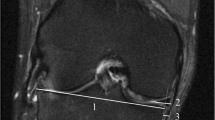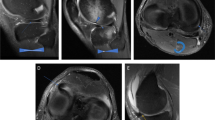Abstract
Objective
Accurate assessment of knee articular cartilage is clinically important. Although 3.0 Tesla (T) MRI is reported to offer improved diagnostic performance, literature regarding the clinical impact of MRI field strength is lacking. The purpose of this study is to compare the diagnostic performance of clinical MRI reports for assessment of cartilage at 1.5 and 3.0 T in comparison to arthroscopy.
Materials and methods
This IRB-approved retrospective study consisted of 300 consecutive knees in 297 patients who had routine clinical MRI and arthroscopy. Descriptions of cartilage from MRI reports of 165 knees at 1.5 T and 135 at 3.0 T were compared with arthroscopy. The sensitivity, specificity, percent of articular surfaces graded concordantly, and percent of articular surfaces graded within one grade of the arthroscopic grading were calculated for each articular surface at 1.5 and 3.0 T. Agreement between MRI and arthroscopy was calculated with the weighted-kappa statistic. Significance testing was performed utilizing the z-test after bootstrapping to obtain the standard error.
Results and conclusions
The sensitivity, specificity, percent of articular surfaces graded concordantly, and percent of articular surfaces graded within one grade were 61.4%, 82.7%, 62.2%, and 77.5% at 1.5 T and 61.8%, 80.6%, 59.5%, and 75.6% at 3.0 T, respectively. The weighted kappa statistic was 0.56 at 1.5 T and 0.55 at 3.0 T. There was no statistically significant difference in any of these parameters between 1.5 and 3.0 T. Factors potentially contributing to the lack of diagnostic advantage of 3.0 T MRI are discussed.






Similar content being viewed by others
References
Johnson VL, Hunter DJ. The epidemiology of osteoarthritis. Best Pract Res Clin Rheumatol. 2014;28(1):5–15.
Smith GD, Knutsen G, Richardson JB. A clinical review of cartilage repair techniques. J Bone Joint Surg Am. 2005;87(4):715–24.
Roemer FW, Winalski CS. State of the art: MR imaging after knee cartilage repair surgery1. 2015;277(1).
Bondeson J. Are we moving in the right direction with osteoarthritis drug discovery? Expert Opin Ther Targets. 2011;15(12):1355–68.
Chevalier X, Eymard F, Richette P. Biologic agents in osteoarthritis: hopes and disappointments. Nat Rev Rheumatol. 2013;9(7):400–10.
Crema MD, Roemer FW, Marra MD, Burstein D, Gold GE, Eckstein F, et al. Articular cartilage in the knee: current MR imaging techniques and applications in clinical practice and research. Radiographics. 2011;31(1):37–61.
Kijowski R. Clinical cartilage imaging of the knee and hip joints. AJR Am J Roentgenol. 2010;195(3):618–28.
Figueroa D, Calvo R, Vaisman A, Carrasco MA, Moraga C, Delgado I. Knee chondral lesions: incidence and correlation between arthroscopic and magnetic resonance findings. Arthroscopy. 2007;23(3):312–5.
Friemert B, Oberländer Y, Schwarz W, Häberle HJ, Bähren W, Gerngroß H, et al. Diagnosis of chondral lesions of the knee joint: can MRI replace arthroscopy?: a prospective study. Knee Surg Sports Traumatol Arthrosc. 2004;12(1):58–64.
Quatman CE, Hettrich CM, Schmitt LC, Spindler KP. The clinical utility and diagnostic performance of magnetic resonance imaging for identification of early and advanced knee osteoarthritis: a systematic review. Am J Sports Med. 2011;39(7):1557–68.
Smith TO, Drew BT, Toms AP, Donell ST, Hing CB. Accuracy of magnetic resonance imaging, magnetic resonance arthrography and computed tomography for the detection of chondral lesions of the knee. Knee Surg Sports Traumatol Arthrosc. 2012;20(12):2367–79.
Sonin AH, Pensy RA, Mulligan ME, Hatem S. Grading articular cartilage of the knee using fast spin-echo proton density-weighted MR imaging without fat suppression. Am J Roentgenol. 2002 Nov;179(5):1159–66.
von Engelhardt LV, Lahner M, Klussmann A, Bouillon B, Dàvid A, Haage P, et al. Arthroscopy vs. MRI for a detailed assessment of cartilage disease in osteoarthritis: diagnostic value of MRI in clinical practice. BMC Musculoskelet Disord. 2010;11:75.
Kijowski R, Blankenbaker DG, Munoz Del Rio A, Baer GS, Graf BK. Evaluation of the articular cartilage of the knee joint: value of adding a T2 mapping sequence to a routine MR imaging protocol. Radiology. 2013;267(2):503–13.
Kijowski R, Blankenbaker DG, Woods MA, Shinki K, De Smet AA, Reeder SB. 3.0-T evaluation of knee cartilage by using three-dimensional IDEAL GRASS imaging: comparison with fast spin-echo imaging. Radiology. 2010;255(1):117–27.
Lee SY, Jee WH, Kim SK, Kim JM. Proton density-weighted MR imaging of the knee: fat suppression versus without fat suppression. Skelet Radiol. 2011;40(2):189–95.
Lavdas E, Topalzikis T, Mavroidis P, Kyriakis I, Roka V, Kostopoulos S, et al. Comparison of PD BLADE with fat saturation (FS), PD FS and T2 3D DESS with water excitation (WE) in detecting articular knee cartilage defects. Magn Reson Imaging. 2013;31(8):1255–62.
Kohl S, Meier S, Ahmad SS, Bonel H, Exadaktylos AK, Krismer A, et al. Accuracy of cartilage-specific 3-Tesla 3D-DESS magnetic resonance imaging in the diagnosis of chondral lesions: comparison with knee arthroscopy. J Orthop Surg Res. 2015;10:191.
Masi JN, Sell CA, Phan C, Han E, Newitt D, Steinbach L, et al. Cartilage MR imaging at 3.0 versus that at 1.5 T: preliminary results in a porcine model. Radiology. 2005 Jul;236(1):140–50.
Link TM, Sell CA, Masi JN, Phan C, Newitt D, Lu Y, et al. 3.0 vs 1.5 T MRI in the detection of focal cartilage pathology—ROC analysis in an experimental model. Osteoarthr Cartil. 2006 Jan;14(1):63–70.
Barr C, Bauer JS, Malfair D, Ma B, Henning TD, Steinbach L, et al. MR imaging of the ankle at 3 Tesla and 1.5 Tesla: protocol optimization and application to cartilage, ligament and tendon pathology in cadaver specimens. Eur Radiol. 2007;17(6):1518–28.
Kijowski R, Blankenbaker DG, Davis KW, Shinki K, Kaplan LD, De Smet AA. Comparison of 1.5- and 3.0-T MR imaging for evaluating the articular cartilage of the knee joint 1. Radiology. 2009;250(3):839–48.
Van Dyck P, Kenis C, Vanhoenacker FM, Lambrecht V, Wouters K, Gielen JL, et al. Comparison of 1.5- and 3-T MR imaging for evaluating the articular cartilage of the knee. Knee Surg Sports Traumatol Arthrosc. 2014;22(6):1376–84.
Curl WW, Krome J, Gordon ES, Rushing J, Smith BP, Poehling GG. Cartilage injuries: a review of 31,516 knee arthroscopies. Arthroscopy. 1997;13(4):456–60.
Landis JR, Koch GG. The measurement of observer agreement for categorical data. Biometrics. 1977 Mar;33(1):159–74.
Wong S, Steinbach L, Zhao J, Stehling C, Ma CB, Link TM. Comparative study of imaging at 3.0 T versus 1.5 T of the knee. Skelet Radiol. 2009;38(8):761–9.
Omoumi P, Michoux N, Larbi A, Lacoste L, Lecouvet FE, Perlepe V, et al. Multirater agreement for grading the femoral and tibial cartilage surface lesions at CT arthrography and analysis of causes of disagreement. Eur J Radiol. 2017;88:95–101.
Palazzetti V, Guidi F, Ottaviani L, Valeri G, Baldassarre S, Giuseppetti GM. Analysis of mammographic diagnostic errors in breast clinic. Radiol Med. 2016;121(11):828–33.
Berbaum KS, Krupinski EA, Schartz KM, Caldwell RT, Madsen MT, Hur S, et al. Satisfaction of search in chest radiography 2015. Acad Radiol. 2015;22(11):1457–65.
Schartz KM, Madsen MT, Kim J, Ohashi R, Ohashi K, El-Khoury GY, et al. Trauma in CT: the role of severe injury on satisfaction of search revised. J Am Coll Radiol. 2016;13(8):973–978.e4.
Marx RG, Connor J, Lyman S, Amendola A, Andrish JT, Kaeding C, et al. Multirater agreement of arthroscopic grading of knee articular cartilage. Am J Sports Med. 2005;33(11):1654–7.
Acebes C, Roman-Blas JA, Delgado-Baeza E, Palacios I, Herrero-Beaumont G. Correlation between arthroscopic and histopathological grading systems of articular cartilage lesions in knee osteoarthritis. Osteoarthr Cartil. 2009;17(2):205–12.
Cameron ML, Briggs KK, Steadman JR. Reproducibility and reliability of the outerbridge classification for grading chondral lesions of the knee arthroscopically. Am J Sports Med. 2003;31(1):83–6.
Sando MJ, Rajaee SS, Liu JP, Banffy M, Limpisvasti O, Crues JV. Identifying hidden zones of the far posterior cartilage of the femoral Condyles not visible during knee arthroscopy. 2017;W1–6.
Fritz J, Janssen P, Gaissmaier C, Schewe B, Weise K. Articular cartilage defects in the knee-basics, therapies and results. Injury. 2008;39(1 SUPPL):50–7.
Kumagai K, Akamatsu Y, Kobayashi H, Kusayama Y, Koshino T, Saito T. Factors affecting cartilage repair after medial opening-wedge high tibial osteotomy. Knee Surg Sports Traumatol Arthrosc. 2017;25(3):9–14.
Stevens KJ, Busse RF, Han E, Brau ACS, Beatty PJ, Beaulieu CF, et al. Ankle: isotropic MR imaging with 3D-FSE-cube—initial experience in healthy volunteers. Radiology. 2008;249(3):1026–33.
Van Dyck P, Gielen JL, Vanhoenacker FM, De Smet E, Wouters K, Dossche L, et al. Diagnostic performance of 3D SPACE for comprehensive knee joint assessment at 3 T. Insights Imaging. 2012;3(6):603–10.
Chen CA, Kijowski R, Shapiro LM, Tuite MJ, Davis KW, Klaers JL, et al. Cartilage morphology at 3.0T: assessment of three-dimensional magnetic resonance imaging techniques. J Magn Reson Imaging. 2010;32(1):173–83.
Crema MD, Nogueira-Barbosa MH, Roemer FW, Marra MD, Niu J, Chagas-Neto FA, et al. Three-dimensional turbo spin-echo magnetic resonance imaging (MRI) and semiquantitative assessment of knee osteoarthritis: comparison with two-dimensional routine MRI. Osteoarthr Cartil. 2013;21(3):428–33.
Friedrich KM, Reiter G, Kaiser B, Mayerhöfer M, Deimling M, Jellus V, et al. High-resolution cartilage imaging of the knee at 3 T: basic evaluation of modern isotropic 3D MR-sequences. Eur J Radiol. 2011;78(3):398–405.
Schaefer FKW, Kurz B, Schaefer PJ, Fuerst M, Hedderich J, Graessner J, et al. Accuracy and precision in the detection of articular cartilage lesions using magnetic resonance imaging at 1.5 Tesla in an in vitro study with orthopedic and histopathologic correlation. Acta Radiol. 2007;48(10):1131–7.
Kijowski R, Gold GE. Routine 3D magnetic resonance imaging of joints. J Magn Reson Imaging. 2011;33(4):758–71.
Notohamiprodjo M, Horng A, Kuschel B, Paul D, Li G, Raya JG, et al. 3D-imaging of the knee with an optimized 3D-FSE-sequence and a 15-channel knee-coil. Eur J Radiol. 2012;81(11):3441–9.
Van Dyck P, Vanhevel F, Vanhoenacker FM, Wouters K, Grodzki DM, Gielen JL, et al. Morphological MR imaging of the articular cartilage of the knee at 3 T—comparison of standard and novel 3D sequences. Insights Imaging. 2015;6(3):285–93.
Yoshioka H, Stevens K, Hargreaves BA, Steines D, Genovese M, Dillingham MF, et al. Magnetic resonance imaging of articular cartilage of the knee: comparison between fat-suppressed three-dimensional SPGR imaging, fat-suppressed FSE imaging, and fat-suppressed three-dimensional DEFT imaging, and correlation with arthroscopy. J Magn Reson Imaging. 2004;20(5):857–64.
Kijowski R, Davis KW, Woods MA, Lindstrom MJ, De Smet AA, Gold GE, et al. Knee joint: comprehensive assessment with 3D isotropic resolution fast spin-echo MR imaging—diagnostic performance compared with that of conventional MR imaging at 3.0 T. Radiology. 2009;252(2):486–95.
Ristow O, Steinbach L, Sabo G, Krug R, Huber M, Rauscher I, et al. Isotropic 3D fast spin-echo imaging versus standard 2D imaging at 3.0 T of the knee—image quality and diagnostic performance. Eur Radiol. 2009;19(5):1263–72.
Milewski MD, Smitaman E, Moukaddam H, Katz LD, Essig DA, Medvecky MJ, et al. Comparison of 3D vs. 2D fast spin echo imaging for evaluation of articular cartilage in the knee on a 3 T system scientific research. Eur J Radiol. 2012;81(7):1637–43.
Author information
Authors and Affiliations
Corresponding author
Ethics declarations
Conflict of interest
The authors declare that they have no conflict of interest.
Rights and permissions
About this article
Cite this article
Mandell, J.C., Rhodes, J.A., Shah, N. et al. Routine clinical knee MR reports: comparison of diagnostic performance at 1.5 T and 3.0 T for assessment of the articular cartilage. Skeletal Radiol 46, 1487–1498 (2017). https://doi.org/10.1007/s00256-017-2714-6
Received:
Revised:
Accepted:
Published:
Issue Date:
DOI: https://doi.org/10.1007/s00256-017-2714-6




